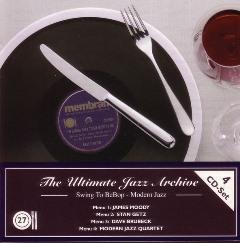The Ultimate Jazz Archive Vol.108 – The Modern Jazz Quartet [1951-1955] [2005]
The Ultimate Jazz Archive Vol.108 – The Modern Jazz Quartet [1951-1955] [2005]

01.Milt Meets Sid 02.D & E 03.Yesterdays 04.Between The Devil And The Deep Blue Sea 05.Autumn Breeze 06.Moving Nicely 07.Bluesology 08.Round About Midnight 09.Love Me Pretty Baby 10.Heart And Soul 11.True Blues 12.Ralph’s New Blues 13.All Of You 14.I’ll Remember April 15.Gershwin Medley
Pianist John Lewis, vibraphonist Milt Jackson, bassist Ray Brown and drummer Kenny Clarke first came together as the rhythm section of the 1946 Dizzy Gillespie & His Orchestra and they had occasional features that gave the overworked brass players a well-deserved rest. They next came together in 1951, recording as the Milt Jackson Quartet. In 1952, with Percy Heath taking Brown's place, the Modern Jazz Quartet (MJQ) became a permanent group. Other than Connie Kay succeeding Clarke in 1955, the band's personnel was set. In the early days Jackson and Lewis both were equally responsible for the group's musical direction but the pianist eventually took over as musical director. The MJQ has long displayed John Lewis' musical vision, making jazz seem respectable by occasionally interacting with classical ensembles and playing concerts at prestigious venues, but always leaving plenty of space for bluesy and swinging improvising. Their repertoire, in addition to including veteran bop and swing pieces, introduced such originals as Lewis' "Django" and Jackson's "Bags' Groove." The group recorded for Prestige (1952-55), Atlantic (1956-74), Verve (1957), United Artists (1959) and Apple (1967-69) and, in addition to the many quartet outings, they welcomed such guests as Jimmy Giuffre, Sonny Rollins, the Beaux Arts String Quartet, a symphony orchestra conducted by Gunther Schuller, singer Diahann Carroll (on one piece), Laurindo Almeida, a big band and the Swingle Singers. Although the musicians all had opportunities to pursue individual projects, in 1974 Milt Jackson, tired of the constant touring and the limitations set on his improvising and he quit the group, causing The MJQ to have a final tour and break up. In 1981 Jackson relented and the Modern Jazz Quartet (which has recorded further albums for Pablo and Atlantic) became active again although on a more part-time basis. Connie Kay's health began to fade in the early '90s (Mickey Roker often filled in for him) and after his death in 1995, Albert "Tootie" Heath became his replacement. ---Scott Yanow, Rovi
W 1951 r. czterech dobrze sobie znanych muzyków z big-bandu Dizzy’ego Gillespiego założyło mały zespół studyjny, przyjmując nazwę Milt Jackson Quartet. W zespole tym na wibrafonie grał Milt Jackson, na fortepianie John Lewis, na kontrabasie Ray Brown, na perkusji Kenny Clarke.
W 1951 r. czterech dobrze sobie znanych muzyków z big-bandu Dizzy’ego Gillespiego założyło mały zespół studyjny, przyjmując nazwę Milt Jackson Quartet. W zespole tym na wibrafonie grał Milt Jackson, na fortepianie John Lewis, na kontrabasie Ray Brown, na perkusji Kenny Clarke.
Miejsce Browna zajął wkrótce Percy Heath, a w roku następnym grupa przyjęła nazwę Modern Jazz Quartet. I chociaż pierwotnie muzycy mieli zamiar oddawać się wyłącznie pracy w studio, teraz zaczęli przyjmować również oferty koncertowe. W 1955 r. odszedł Clarke, a zastąpił go Connie Kay. Odtąd, przez następne kilka lat, nowa obsada z Jacksonem, Lewisem, Heathem i Kayem pracowała jako zespół w pełnym wymiarze etatów, redukując w późniejszym okresie swe zespołowe obowiązki do kilku miesięcy w roku.
MJQ zdobył sobie ogromną popularność, ale też budził wiele kontrowersji, traktowano ich bowiem z jednej strony jako "czarną" replikę na "biały" intelektualizm kwartetu Dave’a Brubecka, z drugiej zaś strony artykuowali nowojorską ripostę na styl West Coast z Zachodniego Wybrzeża. Oponenci twierdzili, że ich jazz jest zbyt celebrowany i delikatny. Cokolwiek by mówić, trudno zaprzeczyć, że MJQ wniósł do jazzu swymi interpretacjami szlachetność i profesjonalizm klasycznego kwartetu. W 1974 r. MJQ rozwiązał się, w 1981 r. reaktywował by odbyć lukratywną trasę po Japonii. Okazała się ona wielkim sukcesem, który zachęcił muzyków kwartetu do kontynuowania koncertów i nagrań.
Gdy mowa o tym najbardziej intelektualizującym ze wszystkich zespołów bopowych, należy przyznać, że największą indywidualnością, wywierającą wpływ na innych był pianista John Lewis, reprezentujący w tym kontekście najlepiej pełnię swych możliwości kompozytorskich i cool jazzowego wykonawstwa. W interpretacjach MJQ odbijały się także zainteresowania Lewisa klasyką, co sprawiło, że zaczęto od czasu do czasu klasyfikować ten kwartet, zapewne niesłusznie, w sąsiedztwie "third stream jazzu". Z kolei grę Heatha i Kaya cechował w kwartecie, jak w większości innych obsad, subtelny swing. Jackson z całej czwórki był najbardziej muzycznie nieprzewidywalny, co sprawiało, że nakładane na niego w ramach kwartetu ograniczenia owocowały intrygującymi napięciami w zakresie formy, którą w sensie jazzowym należy zaliczyć do najbardziej emocjonujących elementów nieskazitelnej, cichej i poważnej muzyki MJQ. Śmierć Johna Lewisa, a wcześniej Conniego Kaya, zakończyły definitywnie istnienie MJQ. --- muzyka.onet.pl
download:
uploaded yandex 4shared mega solidfiles zalivalka cloudmailru filecloudio oboom
Last Updated (Thursday, 25 September 2014 17:32)








